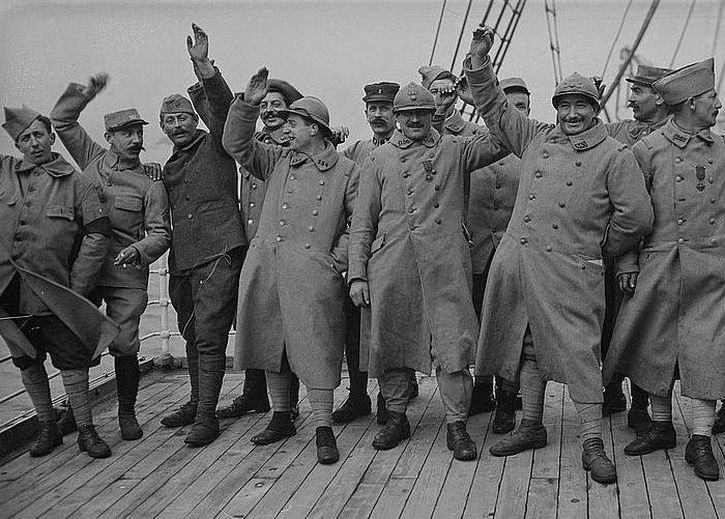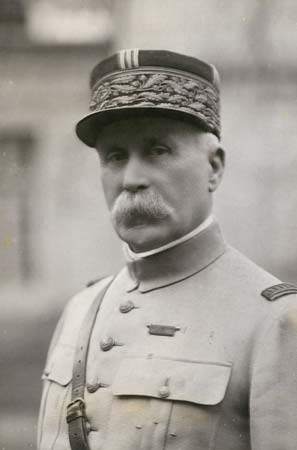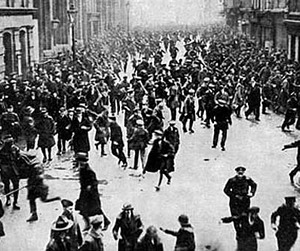Rebellion Targets Paris; French Sack Commander.
First Americans Arrive in France; Too Few to Help.
Special to The Great War Project.
(21 May) The first American military personnel arrive in Europe on May 18th. one hundred years ago.
Some 243 Americans soldiers, according to historian Martin Gilbert, reach Britain. They are the medical staff and orderlies for a base hospital.
A few days later according to Gilbert…
“the first American combat troops arrive in France.” They number 1,308.
They are turning up in the midst of a crisis in the French army. Thousands of French soldiers are walking away from the battlefield. It is wholesale mutiny.

Mutiny in the French army, May 1917.
At the front in France, “as many as 30,000 soldiers have left their trenches and reserve billets and have fallen to the rear.”
Now the mutineers set their sights on Paris. They seize one railway station and try to take it to Paris, without success. They are blocked.
“Troops resting in reserve areas refused to return to the front,” writes historian Adam Hochschild.
The mutineers sing the Internationale, the international communist anthem; they flaunt the red flag.”
Rebellion breaks out in more than thirty divisions. An infantry regiment took over a town and refused to move.

Mutiny shatters French army.
“The scale of the mutinies,” observes Gilbert, “made clear to the French High Command that the soldiers were unwilling to go through the torments of a renewed offensive.”
“They would hold the line, but not go over the top.”
The situation becomes so serious that the French remove the top commanding general, Robert Nivelle. The French fighting spirit is broken.
“Almost immediately after the failure of the offensive on April 14th,” writes war historian John Keegan, “there began what commanders admit are acts of collective indiscipline.” It grows and expands to become known as the mutinies of 1917.
The mutinies originate with French soldiers at the front, but quickly spread to the civilian population of northern France. General Philippe Petain understands better than Nivelle how to end the mutinies. Mutiny is a capital offense. The penalty is death.

French General Philippe Petain.
But under Petain, few soldiers are executed. Instead the French command appeals to the civilian population, asking do you want a German occupation in northern France?
In most places, the answer is a resounding no. Civilians, especially women, writes historian Norman Stone, “told them to go back to the front.”
When General Petain takes over, he takes action that indicates he has heard the mutinous soldiers.
Reports historian Adam Hochschild, “he improved the rest billets behind the lines, upgraded the army’s food, and increased leave.”
Perhaps most significantly, Petain tours the front, speaks to every mutinous regiment, and pledges to refrain from ordering attacks that in his words “waste lives needlessly.”
But Petain understands that much work has to be done to reclaim the loyalty of the troops.

Rebellion in the streets.
To help he mounts a strong appeal to the British Allies , writes Hochschild, “to distract the Germans with a major assault of their own.”
As for the appearance of the Americans, they are arriving in small numbers and are not in a position yet to have an impact on the battlefield.
Nonetheless, they are badly needed.

Was there a military trial held for the French soldiers in the cases of mutiny? How many men died of these charges?
Sorry, to say France still has several documents regarding the Mutiny classifiied and there were so many that were charged but never shot. I have only seen one book that was published on the matter in English and another is out of print. They fired one French General brought in another that gave troops battlefield leave and more leadership! The British had problems too they shot 307 of there own men for cowardice. There are a couple of books regarding Shot at Dawn. The Germans executed some of their Soliders too but it was reported that Kaiser Wilhelm II had estabished excellent benefits and healthcare for his troops. The Dirty business of firing squads was briefly addressed by “Arthur Guy Empey” in his 1918 Book: “Over the Top” (see Google Books.) 1917-1918 24-Americans None were ever shot, France-600 Shot, UK 307, (Germany-WWI-18/ WWII-10,000)
(See French Mutiny: https://tinyurl.com/ldj284s).
(See Shot at Dawn: https://tinyurl.com/ldpb7zw)
Many thanks for your comment. Very helpful.